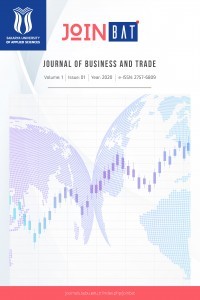Türkiye’de Sağlık Harcamalarının Turizm Gelirleri ve BIST Sağlık Endeksi Üzerine Etkisi
BIST Sağlık Firmaları, Turizm Gelirleri, Sağlık Harcamaları, ARDL
The Effect Of Health Expenditures On Tourism Revenues and BIST Health Index In Turkey
BIST Health Firms, Tourism Revenues, Health Expenditures, ARDL,
___
- Akar, S. (2014). Türkiye’de sağlık harcamaları, sağlık harcamalarının nisbi fiyatı ve ekonomik büyüme arasındaki ilişkinin incelenmesi. Yönetim ve Ekonomi: Celal Bayar Üniversitesi İktisadi ve İdari Bilimler Fakültesi Dergisi, 21(1), 311-322.
- Akdağ, R. (2008). Türkiye Sağlıkta Dönüşüm Programı İlerleme Raporu. Ankara: T.C. Sağlık Bakanlığı. Yayın No: 749
- Akdağ, R. (2012). Sağlıkta Dönüşüm Programı Değerlendirme Raporu (2003-2011). Ankara: T.C. Sağlık Bakanlığı Yayınları.
- Akram, N. (2009). Short Run and long run dynamics of impact of health status on economic growth evidence from Pakistan. MPRA Paper No, 15454, 1-21.
- Bakış, O., Jobert, T. ve Tuncer, R. (2008). Kamu Harcamaları ve Büyüme, Zaman Serileri Analizi. Ed. Kamu Harcamalarının Bileşiminin Büyüme ve Refah Etkileri. Bahçeşehir Üniversitesi Ekonomik ve Toplumsal Araştırmalar Merkezi, 8-105.
- Baltagi, B. H. ve Moscone, F. (2010). Health care expenditure and income in the OECD reconsidered: Evidence from panel data. Economic modelling, 27(4), 804-811.
- Barro, J. R. (1991). Economic growth in a cross section of countries. The Quarterly Journal of Economics, 106(2), 407-443.
- Beraldo, S., Montolio, D. ve Turati, G. (2009). Healthy, educated and wealthy: A primer on the impact of public and private welfare expenditures on economic growth. The Journal of Socio-Economics, 38(6), 946-956.
- Çetin, A. C. (2020). Koronavirüs (Covid-19) salgınının Türkiye'de Genel ekonomik faaliyetlere ve hisse senedi borsa endeksine etkisi. Mehmet Akif Ersoy Üniversitesi Uygulamalı Bilimler Dergisi, 4(2), 341-362.
- Çetin, M. ve Ecevit, E. (2010). Sağlık harcamalarının ekonomik büyüme üzerindeki etkisi: OECD ülkeleri üzerine bir panel regresyon analizi. Doğuş Üniversitesi Dergisi, 11(2),166-182.
- Daştan, İ. ve Çetinkaya, V. (2015). OECD Ülkeleri ve Türkiye’nin sağlık sistemleri, sağlık harcamaları ve sağlık göstergeleri karşılaştırması. SGD-Sosyal Güvenlik Dergisi, 5(1), 104-134.
- Dickey, D. A. ve Fuller, W. A. (1981). Likelihood ratio statistics for autoregressive time series with a unit root. Econometrica, Journal of the Econometric Society. 49(4), 1057-1072.
- Dormont, B., Oliveira Martins, J., Pelgrin, F. ve Suhrcke, M. (2010). Health, Expenditure, Longevity And Growth. Longevity and Growth, IX European Conference.
- Elmi, Z. M. ve Sadeghi, S. (2012). Health care expenditures and economic growth in developing countries: panel co-integration and causality. Middle-East Journal of Scientific Research, 12(1), 88-91.
- Erdil, E. ve Yetkiner, I. H. (2009). The Granger-Causality between health care expenditure and output: A panel data approach. Applied Economics, 41(4), 511-518.
- Eryigit, S. B., Eryigit, K. Y. ve Selen, U. (2012). The long-run linkages between education, health and defence expenditures and economic growth: Evidence from Turkey. Defence and Peace Economics, 23(6), 559-574.
- Gerdtham, U. G., Søgaard, J., Andersson, F. ve Jönsson, B. (1992). An econometric analysis of health care expenditure: A cross-section study of the OECD Countries. Journal Of Health Economics, 11(1), 63-84.
- Gupta, S., Verhoeven, M. ve Tiongson, E. R. (2002). The effectiveness of government spending on education and health care in developing and transition economies. European Journal Of Political Economy, 18, 717-737.
- Hansen, P. ve King, A. (1996). The determinants of health care expenditure: A cointegration approach. Journal Of Health Economics, 15(1), 127-137.
- Jolliffe, I. T. (2002). Principal Component Analysis. Springer-Verlag, NewYork.
- Kar, M., ve Taban, S. (2003). Kamu harcama çeşitlerinin ekonomik büyüme üzerine etkileri. Ankara Üniversitesi S.B.F. Dergisi, 58 (3), 145-169.
- Karagöz, K. ve Tetik, N. (2009). Kamu sağlık harcamalarını belirleyen faktörler: Ekonometrik bir değerlendirme. EconAnadolu 2009: Anadolu Uluslararası İktisat Kongresi, 17-19.
- Kuhn, M. ve Prettner, K. (2016). Growth and welfare effects of health care in knowledge-based economies. Journal Of Health Economics, 46, 100-119.
- McCoskey, S. K. ve Selden, T. M. (1998). Health care expenditures and gdp: Panel data unit root test results. Journal of Health Economics, 17(3), 369-376.
- Mehrara, M. ve Musai, M. (2011). Granger causality between health and economic growth in oil exporting countries. Interdisciplinary Journal of Research in Business, 1(8), 103-108.
- Öksüzler, O. ve Turhan, A. (2005). Does better health promote economic growth in Turkey. International Journal of Business, Management and Economics, 1(4), 5-15.
- Pesaran, M. H., Shin, Y. ve Smith, R. (2001). Bounds testing approaches to the analysis of level relationship. Journal of Applied Econometrics, 16(3), 289-326.
- Phillips, P. C. ve Perron, P. (1988). Testing for a unit root in time series regression. Journal Of Biometrika, 75(2), 335-346.
- Taban, S. (2004). Türkiye’de sağlık ve ekonomik büyüme ilişkisi: Nedensellik testi. III. Ulusal Bilgi Yönetim Kongresi, 3–12.
- Tang, C. F. (2011). Multivariate granger causality and the dynamic relationship between health care spending, income and relative price of health care in Malaysia. Hitotsubashi Journal of Economics, 199-214.
- Türkiye Cumhuriyeti Sağlık Bakanlığı (2012). Türkiye Sağlıkta Dönüşüm Programı. Erişim Linki: https://sbu.saglik.gov.tr/Ekutuphane/kitaplar/SDPturk.pdf. Erişim Tarihi: 26.07.2021.
- Wang, YC, McPherson, K., Marsh, T., Gortmaker, SL ve Brown, M. (2011). ABD ve İngiltere'de öngörülen obezite eğilimlerinin sağlık ve ekonomik yükü. Lancet, 378 (9793), 815-825.
- WHO, (2018). Dünya Sağlık Örgütü. Sağlığın sosyal belirleyicileri: anahtar kavramlar. URL: http://www.who.int/social_determinants/thecommission/finalreport/key_concepts/en/index.html.
- Yayın Aralığı: Yılda 2 Sayı
- Başlangıç: 2020
- Yayıncı: Sakarya Uygulamalı Bilimler Üniversitesi
Green Practices in Supply Chain Management: Case Studies
Ziynet KARABACAK, Mehmet Sıtkı SAYGILI
İbrahim AKDOĞAN, Tülin AKDOĞAN, Nurullah ALTUN
Bankalarda Kredi Kalitesini Etkileyen Reel Sektör Faktörleri
Eyüp KADIOĞLU, Niyazi TELÇEKEN
Employee Rewarding System and Small and Medium Scale Enterprises Performance In Developing Economy
Nureni Adekunle LAWAL, M. Rachael OJOKUKU
Verimlilik ve Dış Ticaret Hadleri: OECD Ülkeleri İçin Nedensellıik Analizi
Aykut ŞARKGÜNEŞİ, Azize DEMİRHAN
Yönetim Kurulunda Kadın Üye Varlığının Şirket Performansına Etkisi
Endüstri 4.0 Konusunda Yayınlanmış Lisansüstü Tezlerin Bibliyometrik Analizi
Tenzile KARACA, N. Ceren TÜRKMEN
Marka Aşkının Demografik Faktörler Ve Ürün Kategorileri Açısından İncelenmesi
Türkiye’de Sağlık Harcamalarının Turizm Gelirleri ve BIST Sağlık Endeksi Üzerine Etkisi
Ahmet ŞİT, Nuri HACIEVLİYAGİL, Berna DOĞAN BAŞAR
Increasing The Recognition Of Brands Through Digital Marketing
